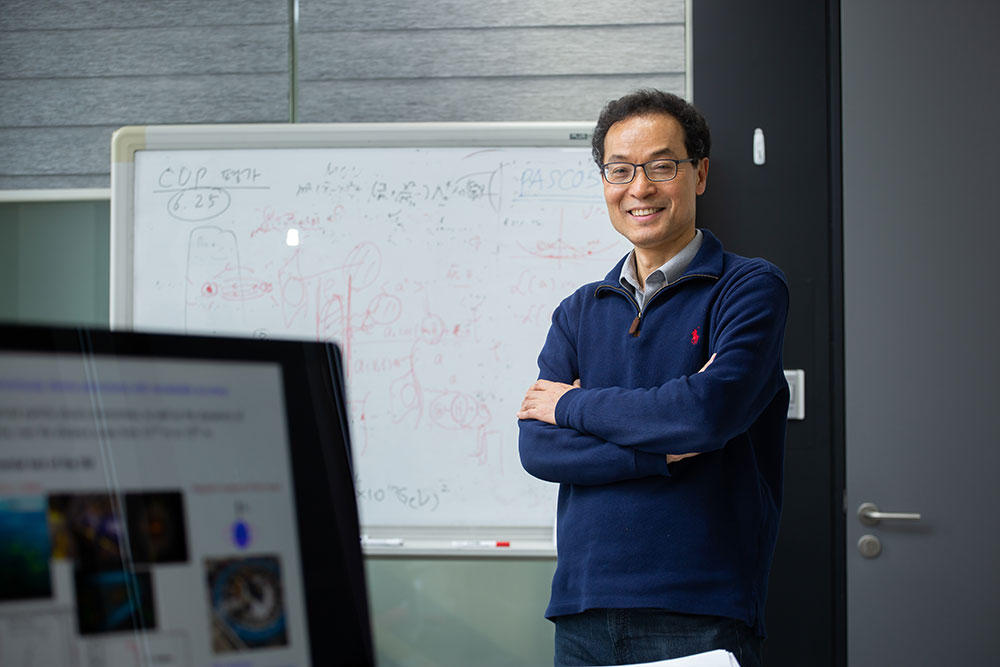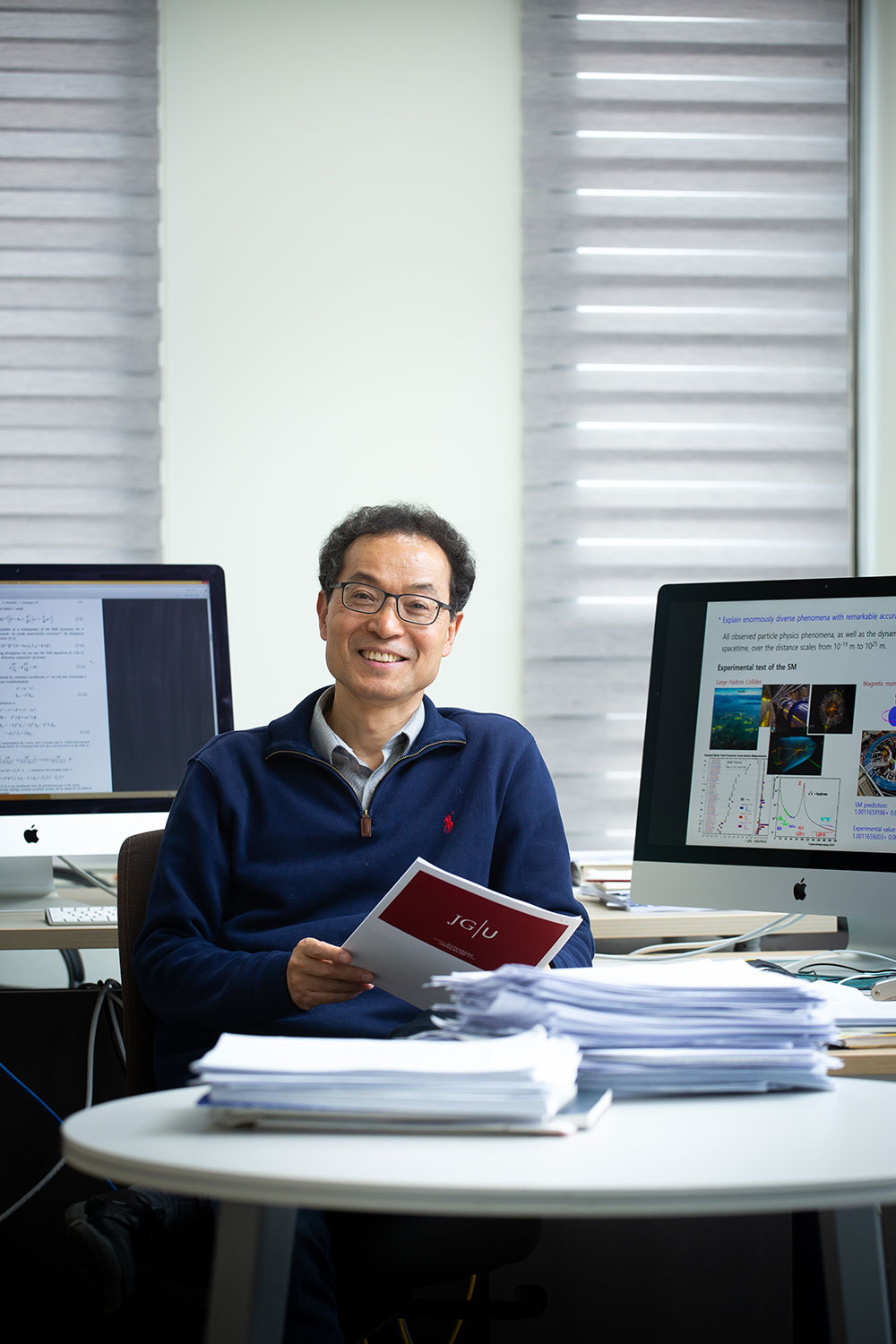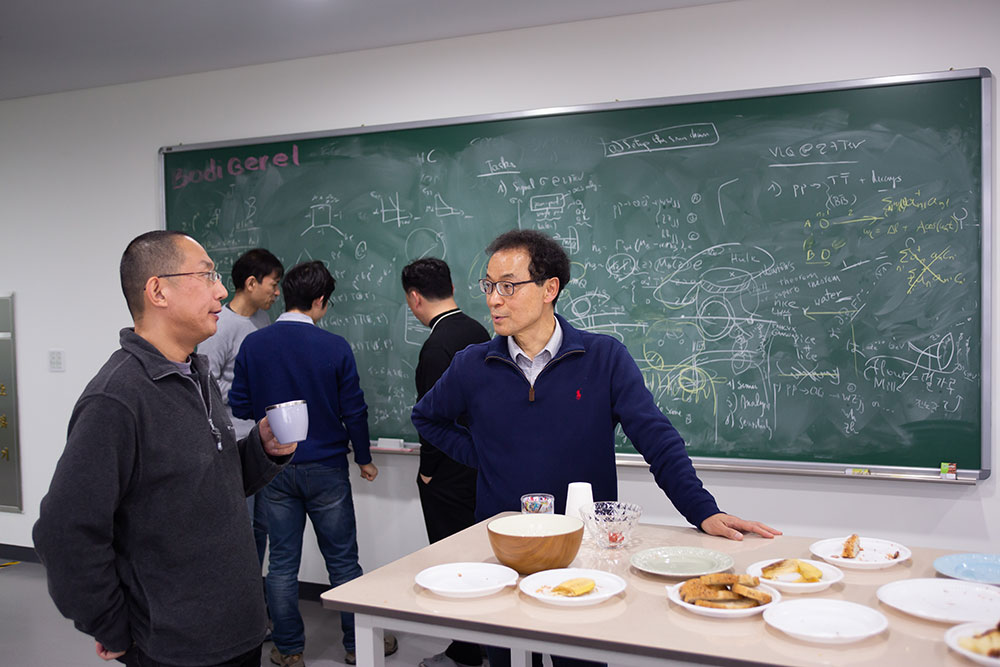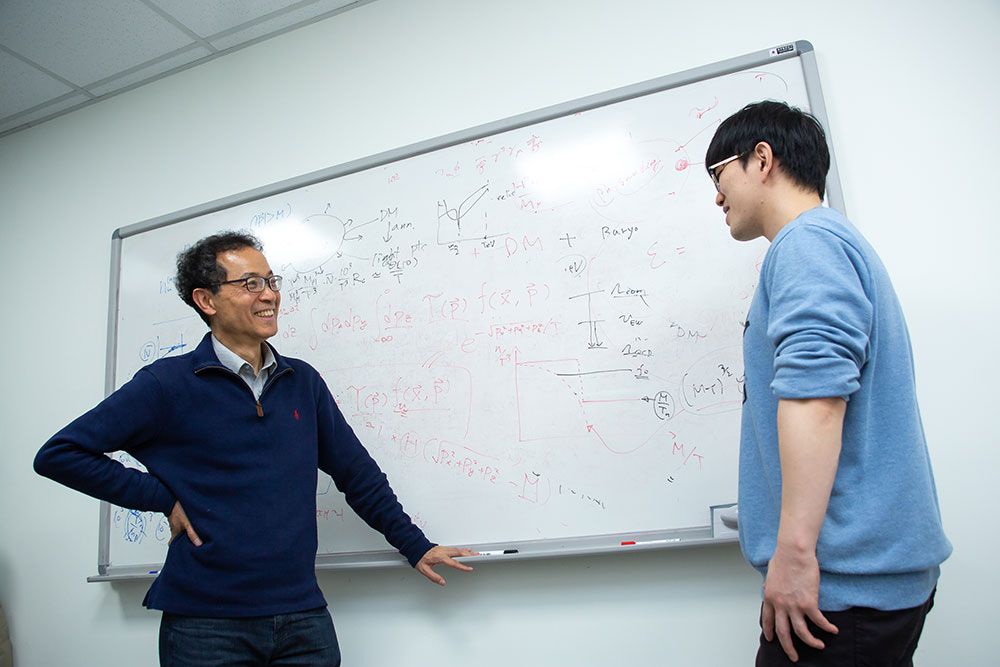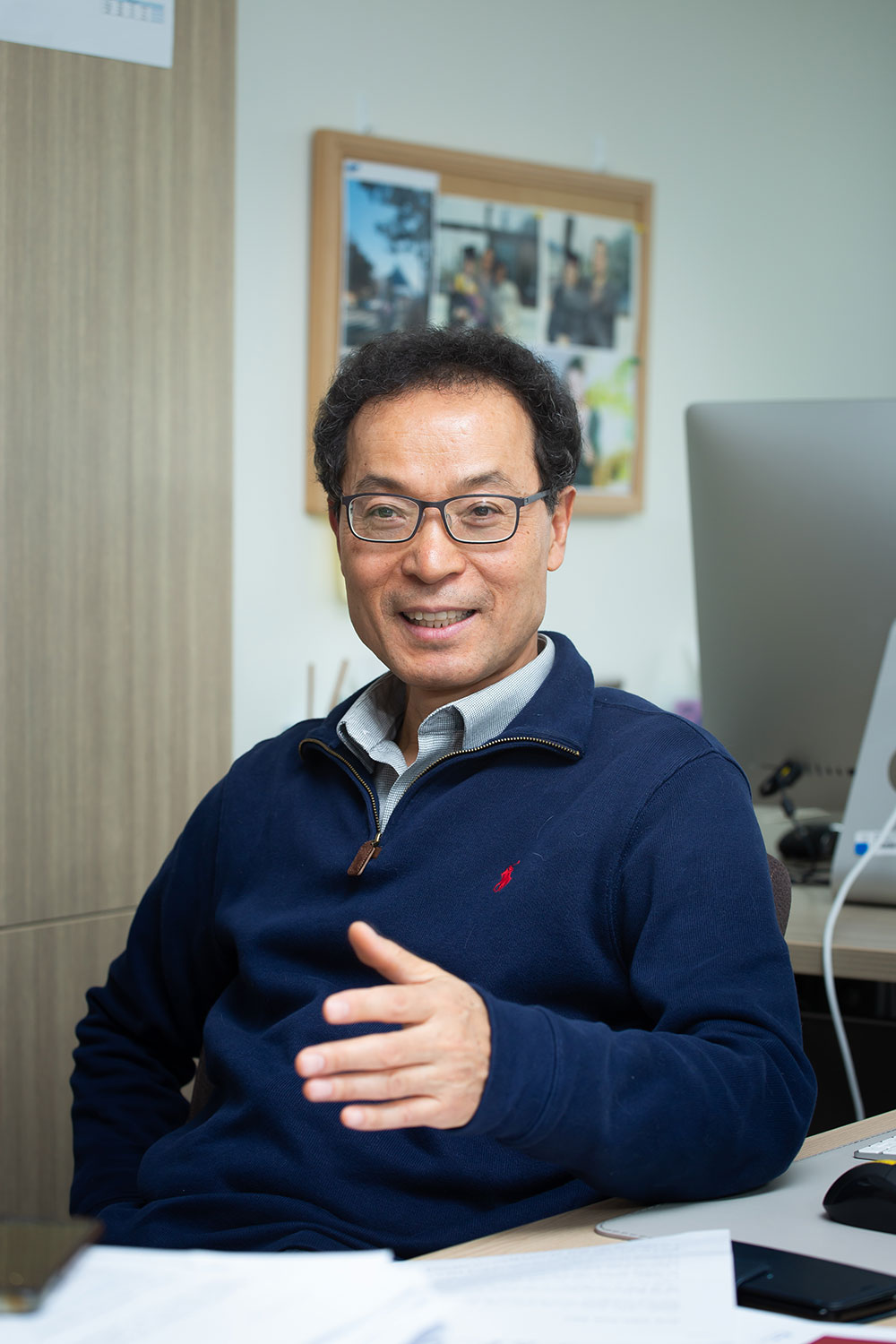주메뉴
- About IBS 연구원소개
-
Research Centers
연구단소개
- Research Outcomes
- Mathematics
- Physics
- Center for Underground Physics
- Center for Theoretical Physics of the Universe (Particle Theory and Cosmology Group)
- Center for Theoretical Physics of the Universe (Cosmology, Gravity and Astroparticle Physics Group)
- Dark Matter Axion Group
- Center for Artificial Low Dimensional Electronic Systems
- Center for Theoretical Physics of Complex Systems
- Center for Quantum Nanoscience
- Center for Exotic Nuclear Studies
- Center for Van der Waals Quantum Solids
- Center for Relativistic Laser Science
- Chemistry
- Life Sciences
- Earth Science
- Interdisciplinary
- Center for Neuroscience Imaging Research (Neuro Technology Group)
- Center for Neuroscience Imaging Research (Cognitive and Computational Neuroscience Group)
- Center for Algorithmic and Robotized Synthesis
- Center for Genome Engineering
- Center for Nanomedicine
- Center for Biomolecular and Cellular Structure
- Center for 2D Quantum Heterostructures
- Center for Quantum Conversion Research
- Institutes
- Korea Virus Research Institute
- News Center 뉴스 센터
- Career 인재초빙
- Living in Korea IBS School-UST
- IBS School 윤리경영


주메뉴
- About IBS
-
Research Centers
- Research Outcomes
- Mathematics
- Physics
- Center for Underground Physics
- Center for Theoretical Physics of the Universe (Particle Theory and Cosmology Group)
- Center for Theoretical Physics of the Universe (Cosmology, Gravity and Astroparticle Physics Group)
- Dark Matter Axion Group
- Center for Artificial Low Dimensional Electronic Systems
- Center for Theoretical Physics of Complex Systems
- Center for Quantum Nanoscience
- Center for Exotic Nuclear Studies
- Center for Van der Waals Quantum Solids
- Center for Relativistic Laser Science
- Chemistry
- Life Sciences
- Earth Science
- Interdisciplinary
- Center for Neuroscience Imaging Research (Neuro Technology Group)
- Center for Neuroscience Imaging Research (Cognitive and Computational Neuroscience Group)
- Center for Algorithmic and Robotized Synthesis
- Center for Genome Engineering
- Center for Nanomedicine
- Center for Biomolecular and Cellular Structure
- Center for 2D Quantum Heterostructures
- Center for Quantum Conversion Research
- Institutes
- Korea Virus Research Institute
- News Center
- Career
- Living in Korea
- IBS School
News Center
| Title | Delving into the origin of the universe and the fundamental laws of nature | ||||
|---|---|---|---|---|---|
| Name | 전체관리자 | Registration Date | 2020-06-10 | Hits | 4503 |
| att. |
 thumb.jpg
thumb.jpg
|
||||
Delving into the origin of the universe and the fundamental laws of natureProf. CHOI Kiwoon, Director, Center for Theoretical Physics of the Universe
“From the perspective of fundamental physics, the world is one big community. All researchers in this field have a common objective of understanding the basic laws of nature and the origin of the universe. When theoretical researchers suggest that there might be something out there, experimental researchers prepare necessary equipment for a long time and attempt to verify that ‘something’ through experiments.” On April 20, 2018, the IBS headquarters complex moved to a site in Expo Science Park in Daejeon, and the Center for Theoretical Physics of the Universe (CTPU) nested in the Theory Building of the new complex. The CTPU joined the IBS HQ in four years after its establishment in early 2014, when Prof. Kiwoon Choi (at KAIST at that time) was appointed as its director. This year marks the fifth anniversary of the CTPU. In an interview with IBS Research, Prof. Choi talked about what he found attractive and difficult in delving into the origin of the universe and the fundamental laws of nature, as well as some of the greatest accomplishments that the CTPU has made so far. Searching for a “new continent”When asked how he felt about having moved to a new IBS HQ, Prof. Choi said, “Because we address theories, the only things we need are desks, white boards, and a space for seminars. When moving from KAIST to here, we moved more easily compared to the Center for Underground Physics, which is next door to us. We are looking forward to creating synergy with our neighbor.” As researchers of the CTPU and the Center for Underground Physics (CUP) can bump into each other almost every day, Prof. Choi is planning to hold joint discussions and perform mutually complementary research projects. He expects that those efforts will bear fruit over time. Prof. Choi said, “I believe that there must be a new physical law that goes beyond the Standard Model* of particle physics. One of the clues is the dark matter, which defies explanation with existing theories.” In this sense, he regards dark matter research as the common interest of both the CTPU and CUP. The Standard Model “From the perspective of fundamental physics, the world is one big community. All researchers in this field have a common objective of understanding the basic laws of nature and the origin of the universe. When theoretical researchers suggest that there might be something out there, experimental researchers prepare necessary equipment for a long time and attempt to verify that ‘something’ through experiments,” said Prof. Choi. Let’s take the Large Hadron Collider (LHC) at the European Organization for Nuclear Research (CERN) for example. Since the early 1980s, many theoretical physicists have focused on supersymmetric theories and suggested the possible existence of superpartners*. Although researchers at the LHC have thoroughly searched for superpartners through particle acceleration and collision experiments, they have not found one yet. Supersymmetry and superpartners Prof. Choi compared the researchers in this field to “explorers looking for a new continent.” He said, “There is credible indirect evidence that there may be a new continent somewhere. However, we don’t know how far we must travel to discover it. We might end up navigating all our lives. Columbus made history by sailing across the Atlantic and reaching a new continent (the West Indies). Otherwise, nobody would have remembered him. Such is our field of research. However, without the countless previous attempts by explorers, the discovery of the new continent would not have been possible. Our aim is to find a new continent of physics. Most scientists might end up saying, ‘I have come this far in search of a new continent, but I have not found one yet.’ Discovering a new world is rare and it is a revolutionary event. That said, the ‘process’ of searching for a new continent will help us improve our knowledge about nature. This is why we continue our research.” Verifying whether a given theory is consistent with our universe
Prof. Choi said, “No matter how beautiful a theory may be, its value won’t be recognized if it is not a theory selected by nature. The ultimate judge of any physical theory is nature, and the core mandate of theoretical physicists is to look for such naturally selected theories. Experiments and observations are the steps on the road to be selected by nature.” At the time when Prof. Choi applied for the director position of the CTPU, he had made meaningful achievements in the field of supersymmetry. The idea of supersymmetry was first proposed in the early 1970s, and it was the early 1980s when the idea began to be regarded to be applicable to particle physics in a significant way. On the brink of the LHC experiment, everyone was expecting the discovery of superpartners and the Higgs boson*, while trying to come up with potentially important issues in unstudied areas at the same time. Prof. Choi studied theories about the mass of superpartners and drew attention by publishing related research results. “If there had been many cases of experimentally discovered superpartners, we could have measured their mass. Unfortunately, however, the basic premise was wrong. Superpartners have not been discovered yet. Their mass must be larger than expected,” said Prof. Choi. The Higgs boson He went on to say, “If the mass of any superpartner had been 2,000 times smaller than that of a hydrogen atom, it would have been discovered in experiments. Now that they have failed to find one, the mass is thought be larger than that. Raising the energy level will increase the probability of finding superpartners.” In order to discover superpartners, plans are being made in various parts of the world to build next-generation accelerators. Above all, a slight upgrade work on the LHC is underway to increase the probability of detecting superpartners through more collisions rather than more energy. In Europe, a plan to construct the Future Circular Collider (FCC, 100 km in circumference), which is a bigger accelerator than the LHC, is under discussion at CERN. In China, a discussion is being conducted on building the Circular Electron Positron Collider (CEPC, 70-100 km in circumference). In Japan, the construction of the International Linear Collider (ILC) has long been discussed and a final decision is expected to be made in the near future. These next-generation machines may allow for the discovery of not only superpartners but also something new that humanity has not imagined before. Finding research topics through various meetings and lively debates
According to the original IBS Plan, the CTPU was to be operated centering on three research groups: Particle Theory and Cosmology Group, the Fields, Gravity and Strings Group (the more mathematically oriented branch), and the Astrophysics Group. Prof. Choi said, “I expected that all of the three research groups would become active at least five years later, if not at the time of the launching of the CTPU. However, we are currently focusing on particle theory and cosmology.” When asked how research is specifically being conducted at the CTPU, Prof. Choi said, “Researchers are given complete autonomy. They can discuss research topics of interest with anyone around and conduct research together.” The CTPU has been operating its research groups on a large scale because researchers from various backgrounds can gather together to come up with novel ideas and collaborative research topics through information exchange and lively debates. Prof. Choi provides enough opportunities for researchers to attend conferences and visit overseas institutes or universities, as well as encouraging them to do as many activities as possible outside the campus. He expects that such an environment will lead to finding good questions and good results. Within the CTPU, various kinds of meetings are held regularly. Prof. Choi said, “Every week, we hold various types of seminars and Journal Clubs, where our group members often introduce interesting articles that they have read recently.” Every Thursday, a CTPU-wide meeting called Journal Club is held, and on Mondays and Fridays, study group meetings are held on particle physics and cosmology, respectively, in search of collaborative research topics. Prof. Choi added by saying, “Every two weeks, we hold a seminar with guest speakers, and we also hold related conferences every year.” Several small conferences are held annually, where overseas experts in the relevant fields are invited, while a considerably large conference with hundreds of participants are generally held once a year. For example, IBS held the “Dark Side of the Universe 2017,” a conference on dark matter and cosmology, in 2017 and the “COSMO-18,” one of the most important conferences in the fields of particle physics and cosmology, in 2018. About 200 to 300 scientists participated in the two conferences. Prof. Choi said, “These conferences are effective means to make our research group known to the international scientific community as a whole, as well as to contribute to the international community which falls within our field. Greatest accomplishments for the last five years
Five years have passed since the launch of the CTPU in 2014. Recently, the research center has undergone its fifth annual assessment as well. Prof. Choi said, “I don’t think that our research performance for the last several years falls behind that of internationally leading research teams in our field.” Prof. Choi found it encouraging that young researchers published many articles in Physical Review Letters (PRL), a high-prestige journal in the field. The following are what Prof. Choi sees as two of the greatest accomplishments that the CTPU has made for the last five years: First, the CTPU was the first to suggest a theoretical framework called the “clockwork mechanism.” In nature, the same constant can be manifested in different values. Let’s take mass for example. The mass of a top quark and the mass of an electron are the same. However, a top quark is more than a million times heavier than an electron. In the case of the mass of a Higgs boson versus Planck mass (mass that determines the strength of gravity), the difference is about 1016-fold. This is as if the weight difference of two identical animals corresponded to that of an ant and an elephant. This “hierarchical structure” can be naturally and effectively explained by the clockwork mechanism, which is based on the fact that in the case of a series of gears meshed with each other (in order of size, from the largest to the smallest), the number of revolutions of each gear increases exponentially (e.g., 1, 21, 22, … 2n). Prof. Choi said, “The research drew a lot of attention from the scientific community in the field. It was an important accomplishment which falls within one of several main ideas that we came up with during the last four to five years.” The other accomplishment is a research paper that interpreted, in a very novel way, a signal which was detected at the LHC in 2015 and regarded (mistakenly) as a new particle. The paper was written on the assumption that the signal was genuine. The signal emitted two photons. Usually, when such a signal is detected, it has been interpreted that a new particle had been created and that the particle had disintegrated into two photons. In contrast, the research team at the CTPU provided a unique interpretation that a newly created particle might have disintegrated into two different types of dark matter as well as two photons. Unfortunately, however, the signal was later found to be a statistical error. Although many scientists became excited as two detectors (CMS and ATLAS) installed at LHC detected the same mass value of the signal, it turned out to be a false signal resulting from a statistical error. Prof. Choi said, “Although the event was treated as a statistical error, the paper has significance in that our interpretation could serve as guidance when a new particle is discovered.” The joy of imagination
Among the research topics addressed at the CTPU, two are typically dealt with by using high-performance computers. Prof. Choi said, “They are mainly used to simulate high-energy particle collisions and the evolution of the universe.” Specifically, the machines are used to find out how to detect genuine signals among countless particles formed by the collision of accelerated particles, as well as how small fluctuations at the initial stage of the universe evolved to form universes and how much influence such fluctuations have on cosmic background radiation. Subsequently, the results obtained through such simulation are compared with observation results. Now that a supercomputer has been installed at the IBS HQ recently, it has become possible to perform research projects that require highly complicated calculations. At his office, Prof. Choi likes to imagine the order of the Universe whenever there is time to spare. He said, “It is very pleasant to think again about what we know about nature. After one or two hours of such thinking, I find myself back to where I started. But I enjoy the thinking process itself. I also check whether we have missed anything or not. In fact, many people have been thinking about it for tens of years, so it is hard to expect to find a missing part. If something new is discovered through experiments, that ‘something’ will guide us. Who could just know about an uncharted way?” Believing that particle physics is the king of science, Prof. Choi regards supersymmetry and the Grand Unified Theory* (GUT) as unavoidable conclusions, given what we know about nature. For example, although an electron and a proton are completely different particles, they have the same size in terms of electric charge (to the 21st decimal place). Prof. Choi said, “If all forces are merged into a single force, everything will be made clear.” Grand Unified Theory “I believe that supersymmetric theories and the GUT are really correct, but there are no experimental clues. What we know is too limited. Only a century ago, we were unable to see beyond our universe, but we can now see trillions of times farther away from us. There might be a breakthrough discovery next year, or we might be living with mysteries that we cannot solve forever. That said, we cannot help but search for a new continent as along as we believe that there must be one,” said Prof. Choi. |
|||||
| Next | |
|---|---|
| before |
- Content Manager
- Public Relations Team : Yim Ji Yeob 042-878-8173
- Last Update 2023-11-28 14:20










